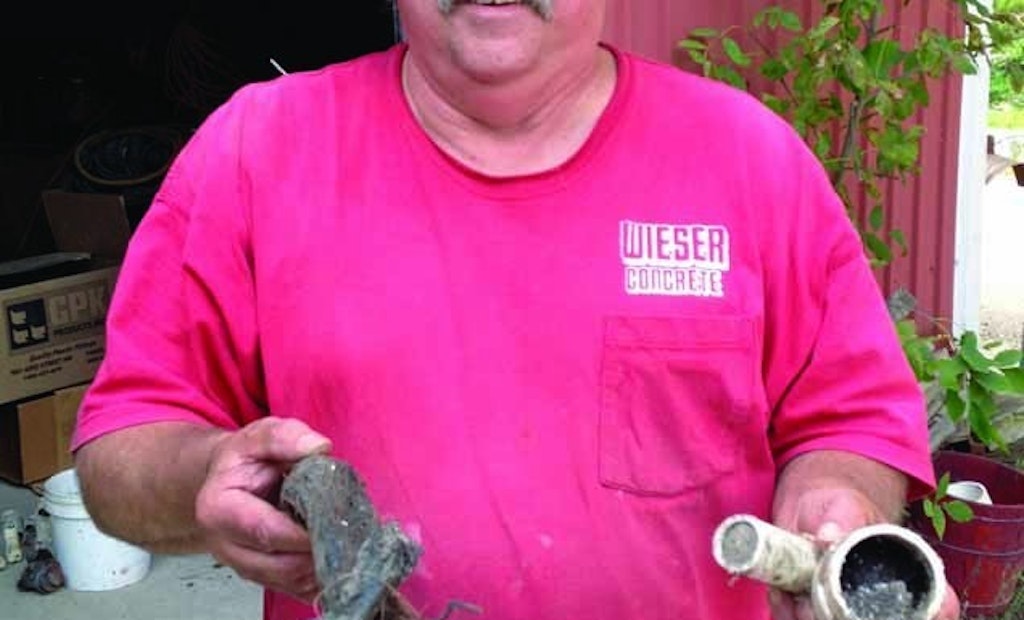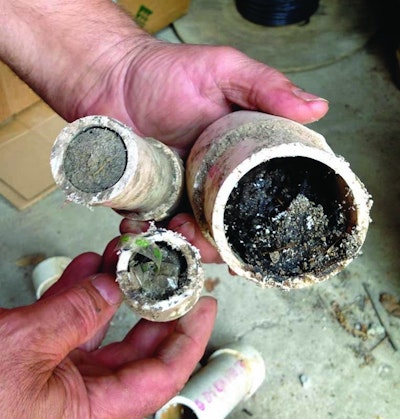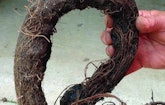
Interested in Septic Tanks?
Get Septic Tanks articles, news and videos right in your inbox! Sign up now.
Septic Tanks + Get AlertsYou’d think when installer Doug Fellner gets a call to replace a burned-out effluent pump in a pressure dose system, the first thing he’d throw in his work truck is a new pump. You’d be wrong. He grabs a 5-gallon bucket of cutoff PVC pipe samples jam-packed with roots and sludge and heads out to educate the customer.
Sometimes homeowners call him, exasperated by having to replace one, two or even three pumps over the course of a few years. But it’s not about the pump, he tells them. It’s about a clog. And if he simply replaces the pump, he’ll be back with another one in six months.
“I will not put a pump in if the laterals aren’t flushed out. I know it’s going to fail,’’ said Fellner, owner of Fellner Soil & Septic Service in Sturgeon Bay, Wisconsin. That’s when it’s time for Fellner to pull out his bucket of props and explain what’s really going on with the customer’s system.
MOUND FAILURE RISING
Several months ago, I made a friendly visit to see Fellner and his wife, Loreen, at their office and noticed his bucket of 2015 cutoff pipe samples from his customers’ systems in Door County, a tourist haven peninsula that juts into Lake Michigan in northeastern Wisconsin. Of course, I had to ask him about the collection, and that’s when I learned about an epidemic of calls he’s been getting for failed pressurized systems, both old and new.
Fellner reckoned he encountered at least 10 systems in 2015 — and several more going back two-three years — where plumbers, other onsite contractors or county inspectors had told homeowners their drainfields — mostly mounds, but some at-grade and inground systems — had failed and needed to be replaced. Some of these systems were 30 years old, some were only 5 years old.
Inevitably, it is recommended the mounds and laterals get ripped out and replaced at a cost of about $6,000 to $7,000 per mound, according to Fellner’s estimate. But Fellner hasn’t been convinced the mounds need replacement, and it usually only takes a look at his bucket of root intrusion samples and a wager with the homeowner to lead to further investigation.
“We’re not going to say the mound failed. We’re going to say there’s a reason the mound failed,’’ Fellner said. “I’ve dug down at the manifold where there’s 120 gallons of water in one spot and it’s not dispersing through the whole mound. I dig up the end of the mound and the gravel is dry.’’
A SURE BET
So he makes a deal with homeowners. His crew will come in, locate the pressurized manifold and laterals, dig down into the mound and cut away a pipe sample from the far end of the line. If the pipe is clear, the customer doesn’t pay for his time. If the pipe is clogged, Fellner restores the system in a process that preserves the mound.
“I show them, ‘Here’s what we’re going to find. There’s going to be a 1 percent chance that the lateral is not clogged.’ I’ve never had one yet where we cut it off and didn’t have a problem,’’ Fellner said.
Because he has seen so many clogged laterals, Fellner developed a relatively quick process to get the onsite systems up and working again. Most of these systems were installed before clean-out sweeps were mandated by the county in the early 2000s, so Fellner uses compact excavation equipment to expose all laterals for inspection. He adds sweeps to the end of each line and calls on another contractor to use a hot jet to clear out root intrusions and sludge buildup. Occasionally jetting doesn’t do the trick and sections of laterals must be replaced. If the septic tank doesn’t have an outlet filter, Fellner recommends installing one to minimize the chance of sludge entering the manifold and laterals. And, of course, burned-out pumps are replaced.
Fellner’s bill is a fraction of the cost of a mound replacement, and he urges homeowners to have the lines flushed as a preventive measure during mandated inspections, every three to six years. Some homeowners will do the work themselves, opening the end of the sweeps and running the pump to flush out the system.
“Any mound that’s been in the ground for five years, I guarantee you’ll get at least a gallon of sludge out of (each lateral),’’ he said.
MAINTENANCE IS KEY
These increasing issues with mounds have less to do with the age of the mounds and more to do with neglect of onsite systems, Fellner asserts. He’s seen very old mound systems that perform perfectly after cleaning out roots and sludge.
“We have mounds out here that were installed in the 1970s and we’ve looked at them and come to the conclusion that they’re working just as good as the day they were installed,’’ Fellner said. “Maintenance is the answer.’’
In addition to periodic maintenance, Fellner looks at the landscape surrounding the mound systems for threats of root intrusion. Water-loving trees whose stringy, fast-growing roots are most likely to find the damp laterals include box elders, cottonwood, cedar and willows. Hardwoods, including maple and oak, are not as inclined to be submerged and are less likely to seek out the pipes, he said.
“To pick on every tree is wrong,’’ he said. The offending varieties “grow right inside the laterals, find the holes and pull nourishment, working their way into the orifices with their hair roots.’’ Once inside the pipe, the roots “get nutrients from the solids. They’re getting a seven-course meal now.’’
Preventing future root intrusion is the key to keeping down long-term maintenance costs, according to Fellner. He suggests removing trees found to be the source of the clogging, ripping out roots that infiltrate the mound and run along the outside of the laterals. He also recommends removing tree stumps to make sure no new growth is possible. Further, he suggests removing all of the inappropriate species of trees up to 100 feet from the mound.
“I tell them they’ve got to get rid of the problem,’’ he said. “Do you want to deal with us every five or 10 years or get the tree cutter in here to get rid of the trees?’’
CARING FOR CUSTOMERS
Fellner is convinced many mounds in his area are replaced unnecessarily and could be fixed at a fraction of the cost. He believes he or other onsite contractors could build a specialty business based on scouring out pressurized pipe and adding lateral sweeps to older systems. For Fellner, providing this service is all about fostering long-term customer relationships and doing the right thing, which is not always the most profitable thing for the installer.
“They might not spend $10,000 with you now, but down the road they may need work or maybe their kids or their friends will,’’ Fellner said. And he said while some customers will use repairs as an opportunity to complain, most homeowners have reasonable expectations about home maintenance issues.
“I tell people they replace the roof on their house every 25 years. Because this is in the ground, it’s out of sight, out of mind,’’ he said. “We hear from people when they have a problem, and we’re in the business of helping people take care of a problem.’’
And for Fellner, the problem-solving often starts with a bucket of clogged pipe samples.
“We went to the old mounds showing problems and found the mound wasn’t the problem. The lateral was the problem,’’ Fellner said. “We have really extended the life of the mounds. It’s really been a godsend to the homeowner.’’







